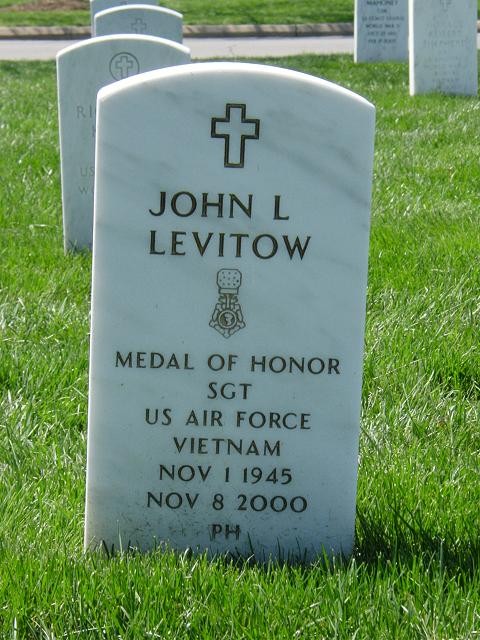John Levitow’s Legacy Will Live Forever
By Senior Airman Oshawn Jefferson, USAF
Air Force Print News
November 17, 2000 — America lost a hero November 8, 2000, when Air Force Medal of Honor holder John L. Levitow died at age 55 at his home in Connecticut after a lengthy battle with cancer.
The Vietnam-era Air Force sergeant was buried with military honors November 17 at Arlington National Cemetery. President Richard M. Nixon presented the Medal of Honor to Levitow on Armed Forces Day, May 14, 1970, for gallantry in combat 15 months earlier.
“This was a sad day for our Air Force,” said Chief Master Sgt. of the Air Force Jim Finch. “John Levitow for years has been woven into the fabric of enlisted heritage. Through his heroic efforts, he was the embodiment of our core value ‘service before self.’ His name has become synonymous with excellence, and his legacy will continue to live in the hearts and minds of all Air Force members today and well into the future.”
Levitow was cited for valor as an AC-47 gunship loadmaster during a mission on February 24, 1969. Flak had severely damaged his aircraft and peppered him with more than 40 shrapnel wounds in his back and legs. Seeing a smoking magnesium flare amid a jumble of spilled ammunition in the cargo bay. Levitow threw himself on the flare and hugged it close as he dragged himself to an open door despite loss of blood and partial loss of feeling in his right leg. As he hurled the flare through the door, it ignited white-hot, but harmlessly outside the aircraft.
“Sergeant Levitow served during a war in which heroic acts were commonplace, but by any standard, his courage that night was extraordinary,” said Secretary of the Air Force Whit Peters. “His selfless actions saved not only his own life but the lives of seven others. For three decades he has been an inspiration to all of our airmen — enlisted, officers and civilians.”
In recounting the event, Levitow had said he remembered the pilot yelling back to the crew, but didn’t remember anything after that. All members in the cargo compartment were wounded, according to history reports. The aircraft sustained more than 3,500 fragment holes in the fuselage and a two-foot-wide hole in the right wing.
“What I did was a conditioned response,” Levitow said in 1998. “I just did it. The next thing I remembered was seeing the landing strip.”
After his Air Force service, Levitow continued a close relationship with the military. He spent 22 years devoted to veterans affairs, and later worked in Connecticut developing and designing veteran programs.
Since 1969, the Air Force has honored him in many different ways
He has been a part of the Air Force Professional Fitness Exam booklet and, as any NCO who has pored over those promotion books knows, Levitow was the lowest ranking airman in history to earn the Medal of Honor.
The Levitow Honor Graduate Award is presented to the top professional military education graduate from Air Force Airman Leadership Schools.
The 737th Training Group Headquarters building at Lackland Air Force Base was named in his honor.
Air Mobility Command named a C-17 Globemaster III after him in 1998. “The Spirit of Sgt. John L. Levitow” is the first to be named for an enlisted person.
Hurlburt Field, Florida, honored Levitow in 1998 by making him part of their Walk of Fame, which honors Medal of Honor recipients.
“John Levitow was a living legend, a true hero to the Air Force family,” said General Michael E. Ryan, Air Force chief of staff. “His courageous, selfless combat actions demonstrate the essence of our core values and will forever serve as a standard for individual sacrifices and service. We will miss him. Our thoughts and prayers of comfort and peace are with the Levitow family.”
Courtesy of the Armed Forces Press Service:
Air Force Sergeant John L. Levitow, one of only 16 airmen awarded the Medal of Honor for exceptional heroism during wartime died November 8, 2000 at his home in Connecticut after a lengthy battle with cancer. He was 55.
Levitow, the lowest ranking airman to earn the medal, received the honor as a result of an incident on February 24, 1969. At that time, the Airman First Class served as load master aboard a severely damaged AC-47 gun ship
flying a mission over Long Bihn, South Vietnam. Suffering from more than 40 shrapnel wounds in his back and legs caused by a mortar blast, he saw a smoking magnesium flare amid a jumble of spilled ammunition canisters.
Despite loss of blood and partial loss of feeling in his right leg, the 23-year-old threw himself on the flare, hugged it close, dragged himself toward an open cargo door and hurled the flare out. Almost simultaneously, the flare ignited harmlessly outside the door and away from the munitions. President Richard M. Nixon presented the Medal of Honor to Levitow on Armed Forces Day, May 14, 1970, at the White House. After Levitow left the Air Force, he worked in the field of veteran’s affairs for more than 22 years. His most recent work was for Connecticut developing and designing veteran programs. Further details and funeral arrangements for a military burial at Arlington National Cemetery are pending.
LEVITOW, John Lee
ROCKY HILL AND SOUTH GLASTONBURY
John Lee Levitow, 55, recipient of the Congressional Medal of Honor, formerly of South Glastonbury, of West St., Rocky Hill, died at his home, Wednesday, (November 8, 2000) after a battle with cancer. Born in Hartford, son of Marion and the late Lee Levitow, he lived in the area all of his life. He was a U.S. Air Force Veteran and received the Congressional Medal of Honor for his bravery, presented by President Richard Nixon. He was active in the V.F.W. Glastonbury Chapter, and the Congressional Medal of Honor Society. He was employed by the State of Connecticut Department of Veterans Affairs as an Assistant to the Commissioner. John is survived by a son, John L. Levitow, Jr. and his friend Lucy Banks, both of North Carolina; his daughter and her husband, Corrie L. and Christopher Wilson of Cromwell; his mother, Marion Levitow of So. Windsor: his sister and her husband, Mary-Lee and Alfred Constantine of East Hartford; and his grandson, Christopher Wilson, Jr. A funeral procession will form Saturday, 9 a.m. at the Glastonbury Funeral Home, 450 New London Tpke., Glastonbury, going to a Mass of Christian Burial at 10 a.m. in St. Augustines Church, Hopewell Road, So. Glastonbury. Burial will be in Arlington National Cemetery at the cemetery’s convenience. Friends may call at the funeral home Friday, 2-4 and 7-9 p.m. Memorial contributions may be made to the American Cancer Society, 538 Preston Ave., P.O. Box 1004, Meriden, CT 06050-1004.
One of the quiet heroes of Vietnam was a loadmaster
who saved his crew on his 180th combat mission.
Airman 1st Class John L. Levitow was handling Mark 24 magnesium flares aboard an AC-47 gunship known as “Spooky 71” on a combat mission near Saigon. It was February 24, 1969.
Spooky 71 and crew had been aloft for 4-1/2 hours when pilot Major Ken Carpenter threw the AC-47 into a turn to engage Viet Cong whose muzzle flashes were visible outside the Long Binh Army Base.
The AC-47, an armed version of the Gooney Bird transport, began spitting 7.62mm machine-gun fire at the enemy below.
As a ground battle unfolded, Spooky 71 trembled from the impact of an explosion. The crew would learn later that a North Vietnamese Army 82mm had landed on top of the right wing and exploded inside the wing frame. Navigator William Platt later said the plane was “lit up like daylight.”
Sgt. Edward Fuzie, wounded in the blast, watched three men be knocked over by the impact, one covered with blood.
Another was Levitow, who mistakenly believed that the AC-47’s machine gun had exploded. Then he was hit by shrapnel that “felt like a two-by-four.” He knew something traumatic had severely damaged the plane but was unsure what.
Carpenter learned over the intercom that everyone in the back of Spooky 71 was wounded and that there was a new mortal danger — a loose, burning Mark 24 magnesium flare had been knocked free in the fuselage and was rolling amid ammunition cans, which contained 19,000 rounds of live ammo.
In less than 20 seconds the AC-47 would become a blazing torch. Levitow had no way to know how many seconds remained on the flare’s fuse. Weak from the loss of blood and numb from 40 wounds on his right side, Levitow realized that he was closest to the flare.
With others seriously wounded, there was no way the crew could bail out.
Time and again, the smoking tube eluded his grasp as the aircraft pitched and rolled. In desperation, he threw himself on the flare and painfully dragged it toward the cargo door, leaving a trail of blood behind. The seconds ticked by. With a final effort, Levitow heaved the flare through the door. It barely cleared the aircraft before igniting.
As recounted in the Air Force’s official history, Carpenter remembered, “The aircraft [was] in a 30-degree bank and how Levitow ever managed to get to the flare and throw it out, I’ll never know.”
Levitow became the first loadmaster ever awarded the Medal of Honor. He is also the youngest and most junior Air Force member to receive the award. In later years, the Air Force named a C-17 Globemaster III in his honor. He resides today in South Windsor, Connecticut.
(Reprinted with the permission of author Robert F. Dorr)
The following message was received
from Paul Helweg on 12 April 2000:
I am a retired Lieutenant Colonel (United States Army) and have been communicating with John Levitow since last September because he was so kind to accept our (Narragansett Council – Boy Scouts of America; Providence, Rhode Island) invitation to honor all “SCOUTS WHO SERVED” in our armed forces during a 15 July 2000 Saturday memorial dedication program in Rockville, Rhode Island.
In any event when I called to check in with John this past Monday (4/10) he was having trouble telling me something. When I came right out and asked him: “John, what’s wrong?” He finally opened up.
It seems John had been diagnosed with some form of cancer last year – he never told me then but I had suspected something when Harvey Barnham (MOH recipient and former President of the Medal of Honor Society) told me on the phone last year that John’s health was not good.
John then told me he had completed a series of Chemotherapy and had had a kidney removed during the past several months. The “hard” part for him to tell me was that he had to soon report to a Boston area hospital for a ten week series of readiation therapy. He was in poor spirits, for obviouls reasons, and he also was not thrilled that he might NOT be able to fulfill his committment to participate in our dedication event. Can you believe that ? – such a great guy to even be thinking of “us” and our memorial dedication event on 15 July 2000 when he’s faced with a life and death struggle? I guess heros such as John Levitow always think of his fellow man before himself!
I wanted to share this with you in the event there may be a way to get the word out on John’s situation? Others should know of this heroes battle for life!
I intend to stay as “close” to John as I can via mail while he’s in the hospital – will even try to visit with him if he will let me. I’ll also try to work through the Medal of Honor Society to identify another MOH recipient to pinch hit for John on 15 July.
Pray for John Levitow!
Best regards,
Paul F. Helweg Jr. LTC (Ret.) USA
Courtesy of the Air Force Association Magazine
October 1984, Vol. 67, No. 10
By John L. Frisbee, Contributing Editor
The Saving of Spooky 71
A1C John Levitow had only seconds to save the lives of eight crewmen aboard the battle-damaged gunship.
Heroism knows neither age nor rank. During World War II and Vietnam, five airmen earned the Medal of Honor. Junior among them was 23-year-old Airman First Class John L. Levitow, loadmaster on an AC-47 gunship, Spooky 71, that on the night of February 24, 1969, went to the aid of besieged troops at Long Binh Army Base a few miles northeast of Saigon. It was John Levitow’s 181st combat sortie.
On operational missions, Loadmaster Levitow was responsible, among other duties, for setting the ejection and ignition controls of the Mark-24 magnesium flares carried by USAF gunships in Southeast Asia. The flares provided illumination for troops on the ground, for the gunship’s pilot to aim his three side-firing 7.62-mm Miniguns, and for fighters that might be called in to help suppress enemy fire.
Once the controls were set, the Mark-24, packed in a three-foot long metal tube weighing about 27 pounds, was passed to a gunner who triggered the arming mechanism and who tossed the tube out the plane’s cargo door. Ten seconds after release, an explosive charge opened the flare’s parachute, and in another 10 seconds the magnesium ignited, generating a light of 2,000,000 candlepower. At 4,000 degrees Fahrenheit, the flare could burn through metal. The Mark-24 was not to be treated casually. Improperly handled, it could be painfully lethal.
On that February night, Spooky 71 had been in the air for four and a half hours when Major Kenneth Carpenter, the aircraft commander, was directed to an area south of the Army base where enemy mortars were laying down a heavy barrage. As the plane arrived at its target area, Levitow handed a flare to Amn. Ellis Owen, whose finger was through the safety pin ring preparatory to tossing the flare through the door at Carpenter’s command.
Suddenly Spooky 71 was rocked by a tremendous blast. An 82-mm mortar shell had exploded inside the gunship’s right wing, showering the cargo compartment with shrapnel. All five crew members in the rear of the plane were hurled to the floor, bleeding from shrapnel wounds. Spooky 71 fell into a steep, descending turn to the right, momentarily out of control. The flare, torn from Owen’s hands by the blast, rolled around the aircraft floor fully armed amidst several thousand rounds of live ammunition for the Miniguns.
Through a haze of pain and shock, Levitow, with 40 shrapnel wounds in his legs, side, and back, saw one of the crew lying perilously close to the open cargo door. As he dragged the wounded man to safety, Levitow spied the armed, smoking flare rolling erratically around the cargo compartment. How long had it been since the safety pin was pulled inadvertently–five seconds? Fifteen seconds?
Levitow had no way of knowing. He did know that the timing mechanism could have been damaged, which might result in premature ignition. In a matter of seconds the flare would ignite, its intense heat turning the stricken gunship into an inferno.
Weakened from loss of blood and partially paralyzed by his wounds, Levitow tried vainly to pick up the flare as it skidded around the floor. The plane was still in a 30-degree bank. Seconds ticked by. Finally, in desperation, he threw himself on the flare, dragged it to the open door, a trail of blood marking his path, and pushed it out just as it ignited in a white-hot blaze. Levitow then lapsed into unconsciousness.
Carpenter managed to regain control of the gunship, its wings and fuselage riddled by 3,500 shrapnel holes, one of them three feet in diameter. Ambulances and a medical evacuation helicopter were waiting on the flight line at Bien Hoa, Spooky 71’s home base, when the battered plane landed with its five injured crewmen–two of them, including John Levitow, seriously wounded. Levitow was flown to a hospital in Japan. After he recovered, he flew 20 more combat missions before returning to the States to complete his enlistment as a C-141 loadmaster at Norton Air Force Base, California.
On Armed Forces Day, May 14, 1970, President Nixon presented the Medal of Honor to Levitow in a ceremony at the White House. The young airman’s heroism in the night sky over Vietnam had added another chapter to the saga of valor that is a vital element of the Air Force heritage.
Courtesy of the Hartford Courant
Hero Always Fought The Good Fight
By TOM CONDON
The Hartford Courant
November 09, 2000
If you passed John Levitow on the street, or met him socially, you’d never learn that he was a Vietnam War hero. He wouldn’t bring it up and wouldn’t elaborate if anyone else did.
He won the Congressional Medal of Honor for a night of incredible heroism in the air over the III Corps region of South Vietnam in February 1969. That was impressive. But what made John stand apart was how he lived his life afterward.
He never swaggered or boasted or cadged drinks at the Legion bar. He never played a celebrity golf tournament that I know of. Instead, he used status and considerable intelligence to help other veterans.
John died early Wednesday morning, after battling cancer for a year and a half, as defiantly as anyone could. He was one of five men awarded the Medal of Honor from Connecticut during the Vietnam War and was, remarkably, the only U.S. Air Force enlisted man ever to have received the nation’s highest medal of valor.
I think you’ll agree that he earned it. He was the load master on an AC-47 working near Long Binh, dropping huge magnesium flares to light the night for ground troops fighting the Viet Cong. The plane flew so low that an enemy mortar round hit the wing.
Mortars scare the hell out of soldiers because they explode in all directions. This one ripped 3,500 holes in the fuselage and a big gash in the wing. Everyone was wounded and slammed into floor and walls. Levitow got to his feet, stunned from the concussion and bleeding from more than 40 shrapnel wounds. He staggered toward the open cargo door to pull a wounded comrade away from the opening.
Then he noticed a more immediate problem. The explosion had wrenched an activated flare away from another crewman. The plane was partly out of control, and the smoking flare, in effect a giant grenade with the pin out, was rolling around on the floor. He couldn’t pick it up, so Levitow threw himself on the flare. Though he’d now lost feeling in his right leg, Levitow dragged the flare to the cargo door and threw it out.
“At that instant, the flare ignited in the air, but clear of the aircraft. Sgt. Levitow, by his selfless and heroic actions, saved the aircraft and its entire crew from certain death and destruction,” according to the Medal of Honor citation.
When the Glastonbury native came back, he was in great demand for Memorial Day and Veterans Day festivities, memorial ceremonies, base festivities, etc. He told me several years ago, in jest, that if his wife had to buy another dress for another dinner they were going to mail the medal back.
He didn’t like these things, particularly, but went to them if they honored veterans. I spoke with his son John Jr., a flight nurse for a hospital in North Carolina, on Wednesday. He said the trips his father did enjoy were ones he made for the Air Force, to meet and talk with enlisted men. “He really wanted to be there for enlisted men,” young John said.
In truth, he was there for whoever needed him. “John’s adult life was about service to veterans,” said Jim Tackett, longtime veterans’ activist who is a program director for the VA in West Haven.
People who worked with him invariably point to his skill at getting grants. Tackett worked with Levitow to get a job-training grant for Connecticut veterans some years ago. “John was amazing. He had all these contacts in Washington. He’d make two phone calls and he’d know exactly how many veterans were being discharged around the globe and were returning to Connecticut.” They got the grant.
And when he got money he used it intelligently, for such things as college courses for veterans. “Some people just take up space,” Tackett said. “John was there to do his job, complete his mission. He was there to get veterans what they needed. And he was completely loyal to whomever he was working for.”
That loyalty was repaid in kind Wednesday by his last boss, state Veterans Affairs Commissioner Eugene A. Migliaro Jr. Migliaro said he’d grown very close to Levitow in the last few years and broke down when he got the call at 3 a.m. Wednesday. “He was a great warrior and a great gentleman. I will pray for him every day of my life,” Migliaro said.
LEVITOW, JOHN L.
Rank and organization: Sergeant, U.S. Air Force,
3rd Special Operations Squadron
Place and date: Long Binh Army Post, Republic of Vietnam, 24 February 1969. Entered service at: New Haven, Connecticut Born: 1 November 1945, Hartford, Connecticut.
Citation:
For conspicuous gallantry and intrepidity in action at the risk of his life above and beyond the call of duty. Sgt. Levitow (then A1c.), U.S. Air Force, distinguished himself by exceptional heroism while assigned as a load master aboard an AC-47 aircraft flying a night mission in support of Long Binh Army Post.
Sgt. Levitow’s aircraft was struck by a hostile mortar round. The resulting explosion ripped a hole 2 feet in diameter through the wing, and fragments made over 3,500 holes in the fuselage. All occupants of the cargo compartment were wounded and helplessly slammed against the floor and fuselage. The explosion tore an activated flare from the grasp of a crew member who had been launching flares to provide illumination for Army ground troops engaged in combat.
Sgt. Levitow, though stunned by the concussion of the blast and suffering from over 40 fragment wounds in the back and legs, staggered to his feet and turned to assist the man nearest to him who had been knocked down and was bleeding heavily. As he was moving his wounded comrade forward and away from the opened cargo compartment door, he saw the smoking flare ahead of him in the aisle. Realizing the danger involved and completely disregarding his own wounds, Sgt. Levitow started toward the burning flare. The aircraft was partially out of control and the flare was rolling wildly from side to side. Sgt. Levitow struggled forward despite the loss of blood from his many wounds and the partial loss of feeling in his right leg. Unable to grasp the rolling flare with his hands, he threw himself bodily upon the burning flare. Hugging the deadly device to his body, he dragged himself back to the rear of the aircraft and hurled the flare through the open cargo door. At that instant the flare separated and ignited in the air, but clear of the aircraft.
Sgt. Levitow, by his selfless and heroic actions, saved the aircraft and its entire crew from certain death and destruction. Sgt. Levitow’s gallantry, his profound concern for his fellow men, at the risk of his life above and beyond the call of duty are in keeping with the highest traditions of the U.S. Air Force and reflect great credit upon himself and the Armed Forces of his country.
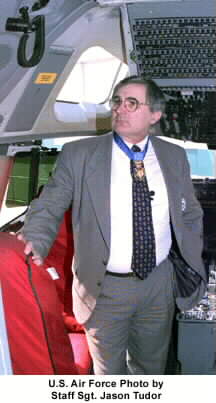
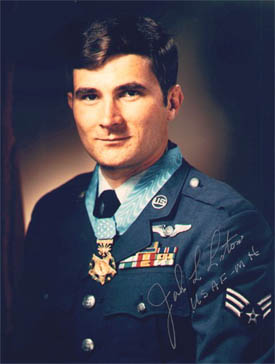
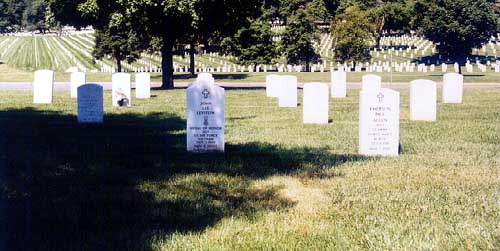
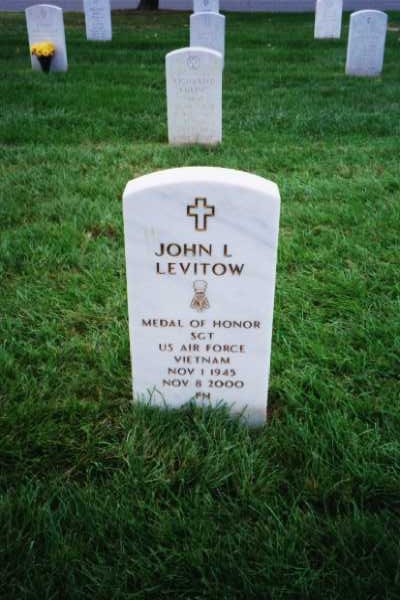
LEVITOW, JOHN LEE
- SGT US AIR FORCE
- VIETNAM
- DATE OF BIRTH: 11/01/1945
- DATE OF DEATH: 11/08/2000
- BURIED AT: SECTION 66 SITE 7107
- ARLINGTON NATIONAL CEMETERY
Michael Robert Patterson was born in Arlington and is the son of a former officer of the US Army. So it was no wonder that sooner or later his interests drew him to American history and especially to American military history. Many of his articles can be found on renowned portals like the New York Times, Washingtonpost or Wikipedia.
Reviewed by: Michael Howard

